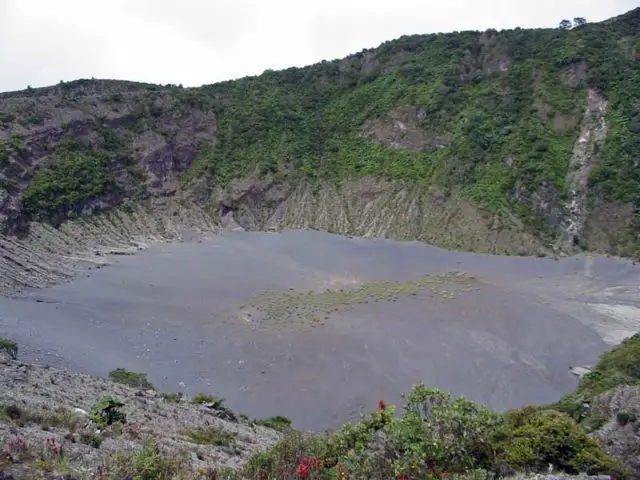Although the Irazú volcano is in a state of rest, it shows signs of its potential danger. A celestial and bubbling lagoon formed a few months ago in its crater, smoking fumaroles in several flanks, hot water springs with volcanic material, and frequent seismicity is part of the signals that keep the experts on alert.
A visit to that Cartaginese colossus, held at the beginning of March, allowed personnel from the Volcanological and Seismological Observatory of Costa Rica (Ovsicori) to document various changes. Although its last strong eruption occurred between 1962 and 1965, it is considered an active volcano.
With the help of a ladder, ropes and instruments, the volcanologist Eliécer Duarte and other experts from the Ovsicori descended to inspect the lagoon of rained water, whose depth is about 10 meters. The bubbling of sulfur-smelling water is at eight points in an area where decades ago other scientists had observed.
“Despite the strong wind, the bubbling points are visible to the naked eye and in the future more sophisticated techniques will be required to sample their gases”, says Duarte.
This phenomenon is a sign of the existence of an underwater crack that has maintained the exhalation of gases and that is impossible to see when the lake dries.

Rash probability: Fairly high
Javier Pacheco, another Ovsicori volcanologist, says that when the magma reaches the surface, as it did in 1962, many decades go by before the material recovers. Therefore, the activity of gas emanation persists for so long, because that hot mass evaporates the filtered water as soon as they make contact.
“The fact that the volcano rests at this moment does not mean that it is not dangerous. The probability of new eruptions in the near future is quite higher, because historically it has demonstrated it. The last century went into activity seven times and the last lasted 3 years”, recalled Pacheco.
Through the cracks magmatic materials also escape that remain as remnants of the last eruptions and that are rarely seen by the thousands of tourists who visit the massif every year. There are springs with high temperatures and concentration of sulfur that are part of the erosion that water generates in the magma that rose.
For volcanologists, the recent transformations found in the crater and in the lake have no immediate implications, but they can be crucial in case of reactivation. “The greater the sealing or the greater the accumulation of consolidated materials in the external part of the main duct, the greater the capacity of overpressure and the explosive capacity”, says the report by Eliécer Duarte.
As there is still deformation in the massif, frequent volcanic earthquakes are generated at the top and this also generates landslides on the west and north flanks. These earth movements forced, months ago, to remove the communication towers that for decades were in a fixed point until the risk became imminent and had to be removed.
Landslides also hamper, partly, the work of volcanologists, since the northeast wall is now so thin that it is risky to move through it and it is feared that it will collapse and interrupt the passage.
They have also formed huge pipes or gullies that run the water rained into the lake. The current activity is poor for a volcano like that, whose episodes have led him to go from having several active craters to one.
Vegetation appears!
Although until a few years ago there were no shrubs in the crater, in this last visit were found trees up to 6 meters high. Plant species such as the “poor man’s umbrella” are very common. Near the vegetation were tracks of coatis, as well as birds and insects that are attracted by flowers and fruits that were previously little observed in this colossus, which is 3,432 meters above sea level.
The above is visible on the northern flank, which seems to have benefited from the fertilizing effect of ash that the wind brings from the Turrialba volcano. The eruptions of the Irazú that have been recorded occurred in 1723, 1917-1920, 1920, 1924, 1928, 1930, 1933, 1939-1940, and 1962-1965.

